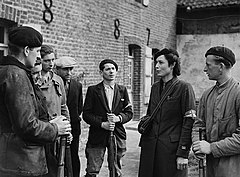Maquis (World War II)

The Maquis (IPA: [ma'ki]) were the predominantly rural guerrilla bands of French Resistance.
Meaning
Originally the word comes from a type of high ground in southeastern France covered with scrub growth. It is the kind of terrain in which the armed resistance groups hid. Members of those bands were called maquisards. Eventually the term became an honorific that meant “armed resistance fighter.” The Maquis have come to symbolize the French Resistance.
Operations
Most maquisards operated in the mountainous areas of Brittany and southern France. They relied on guerrilla tactics to harass the Milice and German occupation troops. The Maquis also aided the escape of downed Allied airmen, Jews and others pursued by the Vichy and German authorities. Some maquisards did commit atrocities, and raid villages as well, but usually they could rely on some degree of sympathy or cooperation from the local populace. In March 1944, the German Army began a terror campaign throughout France. This included reprisals against civilians living in areas where the French Resistance was active.
Most of the Maquis cells - like the Vercors - took names after the area they were operating in. The size of these cells varied from tens to thousands of men and women.
In French Indochina, the local resistance fighting the Japanese since 1941 was backed up by a Special Forces airborne commandos unit created by de Gaulle in 1943, and known as the Corps Léger d'Intervention (CLI). They were supplied by airlifts of the British Force 136.
Politics in Maquis
Politically, maquis were very diverse - from right-wing nationalists to communists and anarchists. Some Maquis bands that operated in southwest France were composed entirely of left-wing Spanish veterans of the Spanish Civil War.
When Germans began a forced labor draft (Service du Travail Obligatoire, STO) in France in the beginning of 1943, thousands of young men fled and joined the Maquis. The British Special Operations Executive (SOE) helped with supplies and agents. The American Office of Strategic Services (OSS) also began to send its own agents to France in cooperation with the SOE and the French BCRA agents in Operation Jedburgh.
The British government also helped and supplied Charles de Gaulle to unify the Free French, resistance movement included.
Role
During the Allied invasion of Normandy, the Maquis and other groups played some role in delaying the German mobilization. The French Resistance (FFI Force Francaises de l'Interieur for "French Forces of the Interior") blew up railroad tracks and repeatedly attacked German Army equipment and garrison trains on their way to the Atlantic coast. Thanks to coded messages transmitted over the BBC radio, each Maquis group was alerted of the impending D-Day by listening for seemingly meaningless messages such as "the crow will sing three times in the morning" or any other pre-arranged messages read in a continuous flow over the British airwaves. As Allied troops advanced, the French Resistance rose against the Nazi occupation forces and their garrisons en masse. For example, Nancy Wake's group of 7,000 maquisards was involved in a pitched battle with 22,000 Germans on June 20, 1944. Some Maquis groups took no prisoners and some German soldiers preferred to surrender to Allied soldiers instead of facing maquisards. Captured Maquis faced torture and being shot or sent to concentration camps, where few survived.
The Allied offensive was slowed and the Germans were able to counterattack in southeast France. On the Vercors plateau, a Maquis group fought about 8000 soldiers under general Karl Pflaum and was defeated with 600 casualties.
When De Gaulle dismissed resistance organizations after the liberation of Paris, many Maquis returned to their homes. Many also joined the new French army to continue the fight.
Customs
It was standard practice among the Maquis to identify members by wearing a Basque beret because it was common enough to not arouse suspicion but distinctive enough to be effective.
Notable maquis
- Maquis du Vercors in the French Alps
- Maquis des Glières in the French Alps
- Maquis du Grésivaudan in the French Alps
- Maquis de Saint-Marcel in Brittany
- Maquis du Mont-Mouchet en Auvergne
- Maquis du Limousin in Massif central
- Maquis de l'Ain et du Haut-Jura
- Maquis de Vabre
- Maquis de Corrèze
- Maquis de Fontjun in the Hérault
- Maquis La Tourette in the Hérault created by Jean Bène
- Maquis de Lozère directed by the German antifascist Otto Kühne
- Corps Franc du Sidobre (Tarn)
